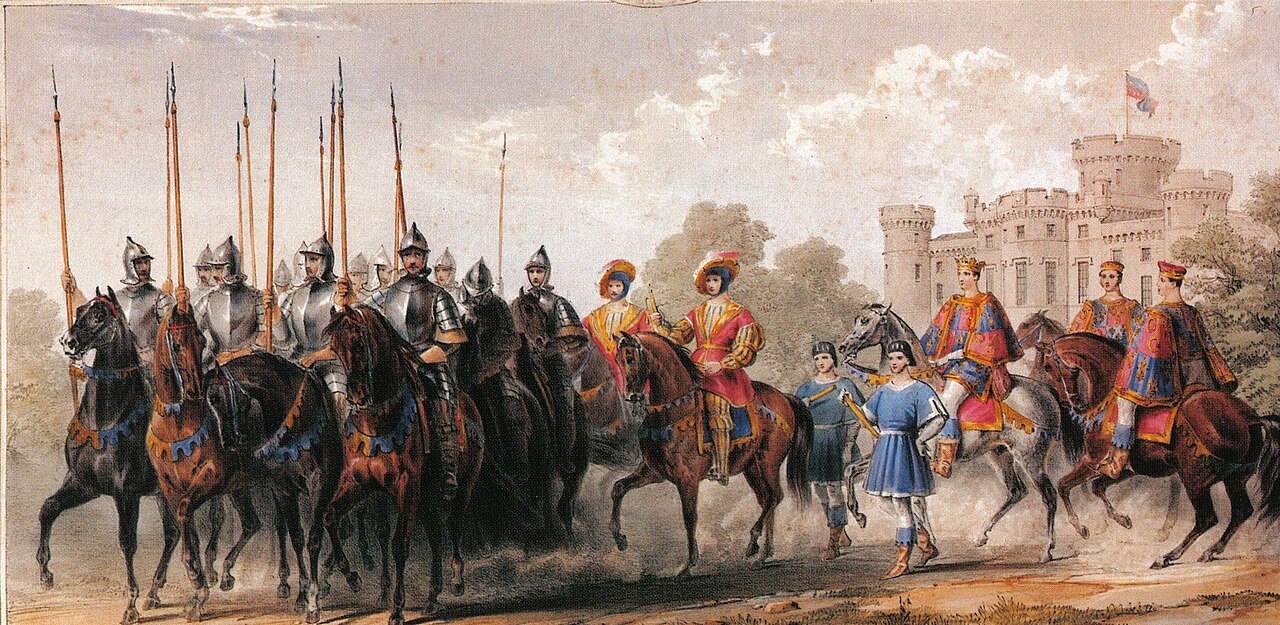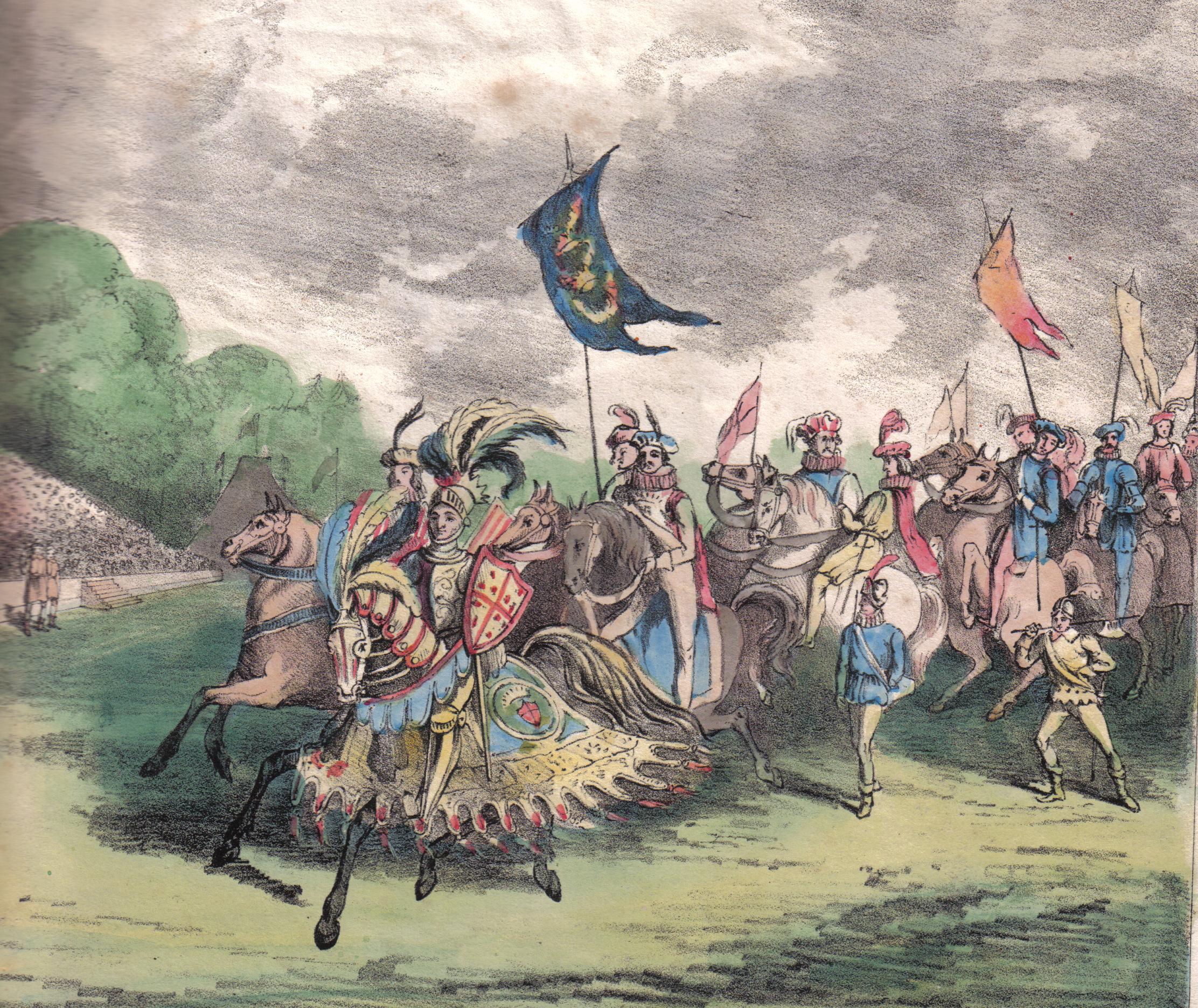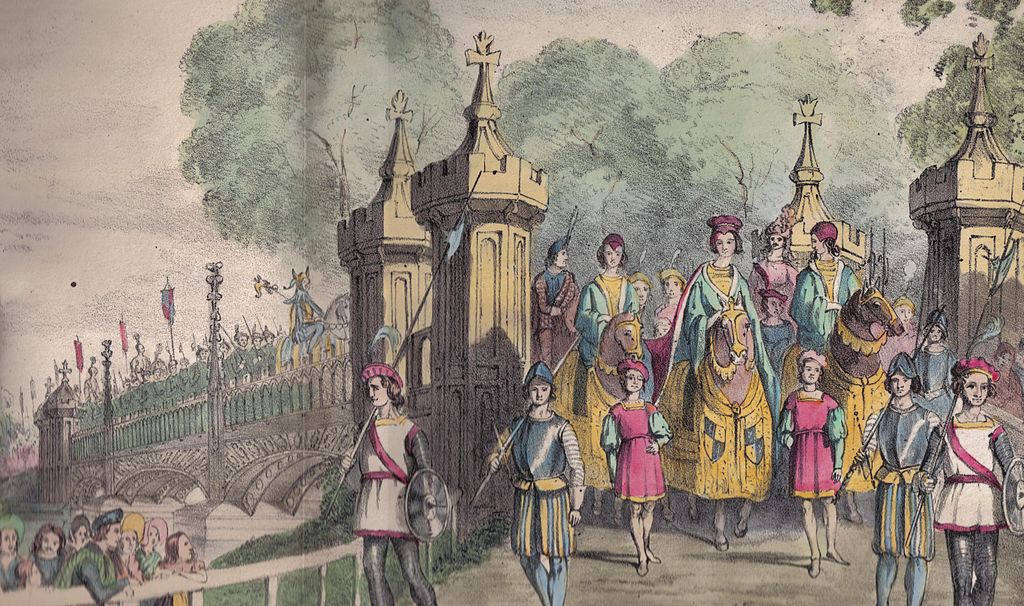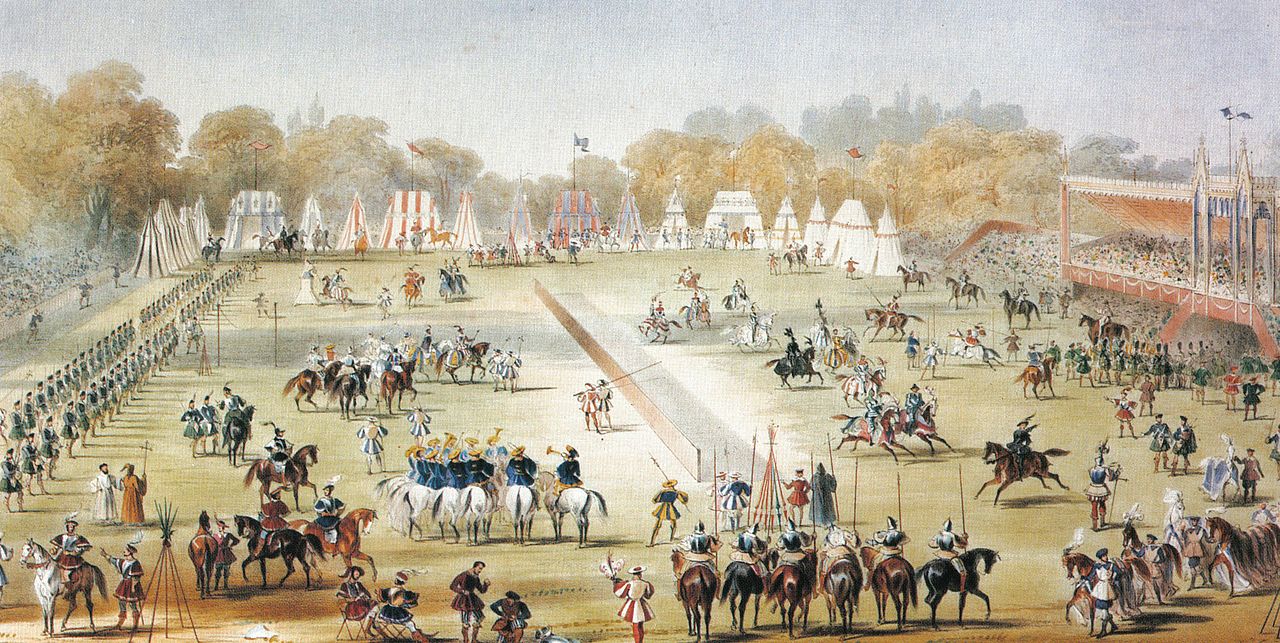(Previous entries in the series:
The Eglinton Tournament:
The First Renaissance Fair
 |
| Don't let the picture fool you. That illustration above took place in 1839! |
In our last issue, we explored the
triumphant return of the Middle Ages in literature, and particularly in how Britons
were reminded of their mythic heritage in the tales of King Arthur. But Arthur
was only the first falling snowball in a veritable avalanche of medieval
literature that was just becoming available after centuries of neglect. John Mitchell
Kemble, a scholar of old Anglo-Saxon and a student of Jacob Grimm (of “the brothers Grimm”), published a modern English translation of Beowulf in 1836, to the great excitement
of both the English and the German world. (The Germans were actually decades
ahead of the English in the medieval revival, but that’s a subject for another post.)
Enthusiasm for Britain’s medieval past reached an all-time high. It inevitably
became time for the Victorians to apply all the pomp and chivalry of the Middle
Ages as they understood it into action. Thus was born the ill-fated Eglinton
Tournament of 1839.

The year prior, Alexandrina Victoria
was crowned Queen of the United Kingdom of Great Britain and Ireland. She
inherited a country in the midst of a recession, and memories of George IV’s
absurdly decadent coronation banquet were still fresh in Britons’ minds. Could
the government justify such lavish spending while so many people were
unemployed, or even starving? Victoria did the “appropriate” thing and cut the
banquet entirely, as well as many other “obsolete” rituals of state associated
with the coronation. One such ritual involved the King’s Champion. Ever since
the Norman Conquest in 1066, the King had a duly appointed champion to fight
duels in his name (as, by protocol, the King could not fight a duel against
anyone but another king). At every coronation banquet, the Champion would ride
into the hall in full plate armor, throw down his gauntlet, and issue a
challenge to all those present:
"If
any person, of whatever degree soever, high or low, shall deny or gainsay our
Sovereign Lord [Name], King of the United Kingdom of Great Britain and Ireland,
Defender of the Faith, son and next heir unto our Sovereign Lord the last King
deceased, to be the right heir to the imperial Crown of this realm of Great
Britain and Ireland, or that he ought not to enjoy the same; here is his
Champion, who saith that he lieth, and is a false traitor, being ready in
person to combat with him, and in this quarrel will adventure his life against
him on what day soever he shall be appointed."—from the words used at the last
coronation banquet in 1821
 |
| George IV's coronation banquet. It's said that his festivities were so sumptuous that people started eating right in the middle of the sermon at Westminster Abbey. |
But those rites were from more
tumultuous times. Britain was a parliamentary government now, was it not? And
so, the rituals of old were cast out, and the nobles who were expected to fill
these roles were snubbed. One such nobleman was Sir Charles Lamb, who as Knight
Marshal of the Royal Household would have led the Champion’s steed into the
banquet hall. His stepson, Archibald Montgomorie, Earl of Eglinton (a staunch
medievalist), was infuriated that the Crown was skimping on the widely loved
ceremonies of state for a “penny crowning”, as Victoria’s coronation came to be
known. The disgruntled nobles got together and decided they would fill the void
in Britain’s sense of pageantry and chivalry by hosting a spectacle of their
own.
It was decided that these
disenfranchised gentlemen would stage a spectacular show of medieval chivalry
and honor at Lord Eglinton’s country manor. That fall, 150 prospective knights answered
the call of duty and assembled at a medieval arms-dealer’s showroom to discuss
the particulars of the tournament. Most soon dropped out when told of the
frighteningly high cost of the armor, horses, squires, livery, and so on. But a
few dozen remained steadfast in their commitment to making this fantasy of the
Middle Ages a reality. Make no mistake: this was no mere staged performance.
The knights who were to fight in the tournament spent the whole following year
in training for the joust. Although the rehearsals held in London were by
invitation only, nobles and commoners alike buzzed with interest, whether it was
eager anticipation or scorn.

Nothing could have prepared Lord
Eglinton for the crowds that arrived on the first day of the tournament. The
tournament itself was free and open to the public, and they arrived in hordes.
A hundred thousand spectators poured in to the tournament grounds, amounting to
the longest traffic jam (over thirty miles from Ayr to Glasgow) in all Scottish
history up to that point. The nearby town had only one hotel. Local residents charged
exorbitant prices for tourists to spend the night in. Others were left sleeping
under the grandstands or even inside tree trunks. Most tragically of all, the
forces of nature decreed Eglinton’s spectacle would end in disaster. In true
Scot style, the first day of the tournament opened with a torrential downpour
from the heavens. Women’s fancy dresses were soaked, the roof on the
grandstands proved useless, and the field itself turned to mud. The first two
knights of the joust, the Hon. Edward Jerningham (the Knight of the Swan) and Captain
James Fairlie (the Knight of the Golden Lion), proved all that training was for
naught. They charged at one another again and again, but neither could actually
land a hit. Fairlie even accidentally dropped his lance, wrapped with his wife’s
handkerchief, into the mud. Worse still, they took their time in between tilts
to adjust their ill-fitting armor, driving the crowds to boredom and ridicule. The
day was only redeemed by the joust of Lord Waterford (the Knight of the Dragon)
and Lord Eglinton (the Lord of the Tournament) himself. Both were sportsmen who
took their training seriously, and at the third tilt, Eglinton broke his lance
squarely against Waterford’s shield.
Nonetheless, the rain had taken its
toll, and despite the presence of many notable nobles such as Prince Louis Napoleon (the future Emperor Napoleon III), the crowds failed to return for the subsequent days of the tourney.
Meanwhile, the Whig press heaped column after column of scorn, scandal, and
mockery over the excesses of the knights and their farcical attempt to recreate
the past. The media’s handling of the Eglinton Tournament was, in many ways, a
blow to the medieval revival because it caricatured the movement as nothing
more than the play-acting of some out-of-touch Tory aristocrats. If Eglinton
failed revive the culture of sport jousting in his own country, though, he
inadvertently inspired the birth of a new jousting tradition in America. A
Marylander by the name of William Gilmor was in attendance at the Tournament.
The next year, he hosted a spectacle of his own in Virginia, kickstarting an entire jousting movement in the antebellum South. These sporting events
undoubtedly served as the forerunner of the modern jousts at the Renaissance fairs
that so many Americans enjoy today.
 |
| The knights process by the Queen's Gallery. |
 |
| Procession across the Tournament Bridge. |
 |
| Lady Seymour, a distant descendant of Henry VIII's third wife, was crowned Queen of Love and Beauty. |
 |
| The melee. |
 |
| The lists. |
 |
| The banquet, served with period-accurate food which reportedly disgusted a lot of the guests. |
 |
| The ball. The men look a bit silly with their non-period, Elvis-like sideburns. |
 |
| The grand prize trophy, made of real silver. Makes the Lombardi Super Bowl trophy look like a cheap souvenir by comparison! |
 |
| An earthenware jug at the Victoria & Albert Museum that commemorates the Tournament. |













Thank you sir, I am enjoying your new blog. Please do provide us with a medieval solution to the national debt.
ReplyDeleteHa. Alexander Hamilton said "national debt is one of the very few important economic phenomena without roots in the ancient world". There are a few isolated examples from the medieval Italian city-states like Genoa and Venice, but for the most part, the medieval world didn't have national debts as we think of them today. At least, certainly not on anywhere near this scale.
DeleteWe dug our own graves on this one. But I might think of something.
Thanks James,
DeleteI knew my question might come off as jackassery, but I am genuinely curious what your thoughts are about this. I just started taking a course at school that so far has made it sound like medieval systems were the cause of all the worlds problems and that we are much wealthier and happier now for doing away with them. I thought you would be the guy to ask about this, since I couldn't help but think our supposed wealth was just an illusion anyway and the national debt came to mind. Thanks again
Very enjoyable read.
ReplyDeleteI don't know if Peter is being serious or a jack-ass. Either way, it is an interesting question.